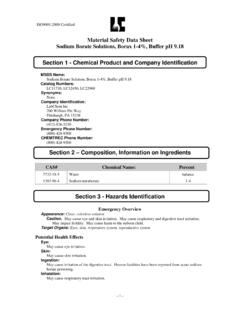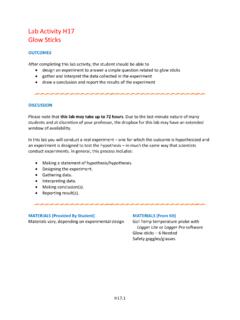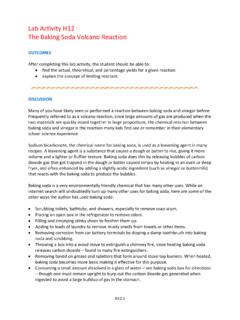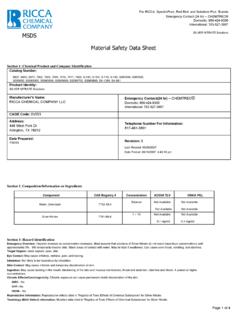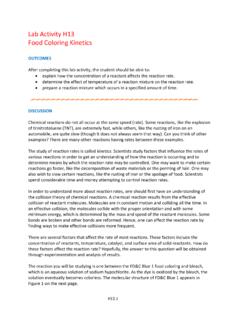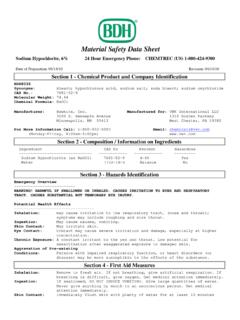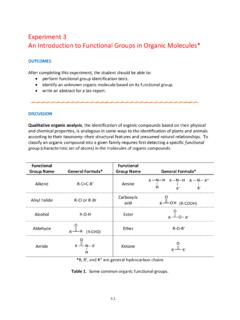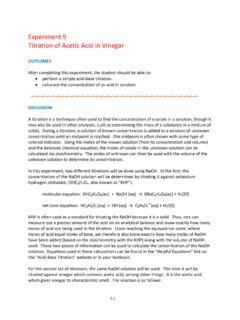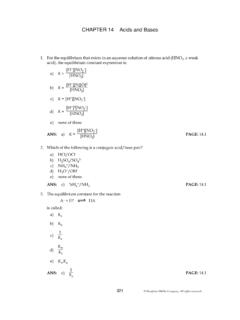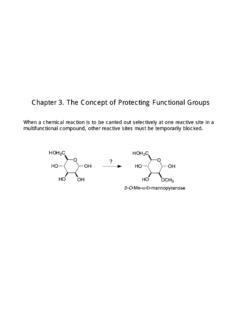Transcription of Chapter 14: Acids and Bases
1 Chapter 14: Acids and Bases Properties of Acids Sour taste React with some metals Turns blue litmus paper red React with Bases Some Common Acids HCl, hydrochloric acid H2SO4, sulfuric acid HNO3, nitric acid HC2H3O2, acetic acid What is the IUPAC name of this (common name) carboxylic acid ? Properties of Bases Some Common Bases Taste bitter NaOH, sodium hydroxide Solutions feel slippery KOH, potassium hydroxide Turns red litmus paper blue NaHCO3, sodium bicarbonate React with Acids Arrhenius acid - base Theory Arrhenius acid - a Because molecular hydrogen containing Acids are not made of compound that ions, they cannot ionizes to produce dissociate. hydrogen ions (H+). when dissolved in They must be pulled water apart, or ionized, by HCl(aq) H+(aq) + Cl (aq) the water. Ch 14 Page 1.
2 Arrhenius Acids and Bases Hydrogen ions released from Acids do not float about freely in solution. Instead, they attach to water molecules to form HYDRONIUM IONS. = H3O+. In the formula for an acid , This hydrogen atom is the one that ionizes the hydrogen atom that ionizes is many times These hydrogen atoms do not ionize in water written first - ex. HC2H3O2. Arrhenius base - a Bases that contain hydroxide containing OH- are ionic compound that compounds. dissociates to produce OH- when dissolved in Ionic substances water dissociate in water. NaOH(aq) Na+(aq) + OH (aq). Arrhenius acid base Reactions The H+ from the acid combines with the OH- from the base to make a molecule of H2O. HCl(aq) + NaOH(aq) NaCl(aq) + H2O(l). ( acid + base salt + water). The cation from the base combines with the anion from the acid to make a salt (an exchange reaction).
3 Ch 14 Page 2. Bronsted-Lowry acid - base Theory Although widely used, the Arrhenius acid - base theory has limitations. (For example, some compounds act as Bases even though they do not contain OH- ). Bronsted-Lowry theory broader definition than Arrhenius theory Bronsted-Lowry acid - any substance that can donate a proton (H+). Bronsted-Lowry base - any substance that can accept a H+. A Br nsted-Lowry acid base reaction is any reaction in which an H+ is transferred. The acid molecule donates an H+ to the base molecule: H A + :B :A + H B+. base structure must Bronsted-Lowry acid - base contain an atom with an reactions don't have to take unshared pair of electrons place in aqueous solution. to bond to H+. Examples: HCl(aq) + H2O(l) Cl (aq) + H3O+(aq). Proton donor Proton acceptor HCl(aq) + NH3(aq) NH4+(aq) + Cl-(aq).
4 Proton donor Proton acceptor Ch 14 Page 3. Conjugate acid - base Pairs Identify the Bronsted-Lowry acid and base in the following reactions: NH3(aq) + H2O(l) NH4+(aq) + OH-(aq). HCO3-(aq) + H2O(l) CO32-(aq) + H3O+(aq). Conjugate Acids and Bases A conjugate acid - base pair is two species that differ from each other by one proton A = acid ; CB = conj. base B = base ; CA = conj. acid HCl(aq) + H2O(l) Cl (aq) + H3O+(aq). A B CB CA. NH2-(aq) + H2O(l) NH3(aq) + OH-(aq). B A CA CB. Identify the conjugate acid - base pairs in the following reactions: HF(aq) + H2O(l) F (aq) + H3O+(aq). NH3(aq) + H2O(l) NH4+(aq) + OH-(aq). Note: Water is an We will not cover Section "Reactions amphoteric molecule - of Acids and Bases " (we already discussed part of this it can function as an acid or a base in ) or Section " acid - base Titration".
5 Ch 14 Page 4. Strong and Weak Acids and Bases A strong acid is an acid that transfers 100% (or nearly 100%) of its acidic hydrogens to water 100% transfer HCl + H2O H3O+ + Cl- Hydrochloric acid : a strong acid Common Strong Acids HCl, HBr, HI, HNO3, H2SO4, HClO4. A weak acid is an acid that transfers only a small amount of its acidic hydrogens to water HC2H3O2 + H2O H3 O+ + C 2 H3 O2 - When acetic acid is Acetic acid : a weak acid dissolved in water only Common Weak Acids of its acidic protons HC2H3O2, HF, H2CO3, H3PO4, H2SO3 are transferred to H2O. of the molecules remain un-ionized. Bases can also be strong or weak Only small amount Common Strong Bases 100% dissociation of dissociation LiOH, NaOH, KOH, Ca(OH)2. Common Weak Bases NaOH Na+ + OH- NH3, HCO3-, CH3NH2. Dissociates 100% (ammonia, bicarbonate, methyl amine).
6 When NH3 reacts with H2O. only a small amount of OH- NH3 + H2O NH4+ + OH- produced Ch 14 Page 5. Self Ionization of Water A VERY SMALL PERCENTAGE (about 1 out of every 10 million). of water molecules can dissociate into H3O+ and OH- H2 O H+ + OH- (Arrhenius). H2 O + H 2 O H3O+ + OH- (Bronsted-Lowry). All aqueous solutions contain both H3O+ and OH . At 25oC, there are equal numbers of hydronium and hydroxide ions: [H3O+] = [OH ] = 1 x 10-7M. at 25 C in pure water Note: [brackets] mean molar concentration in H2O. [H3O+] x [OH ] = Ion Product for Water (Kw). [H3O+] x [OH ] = 1 x 10-14 M. The product of the H3O+ and OH concentrations is constant: 1 x 10-14 M. If H3O+ ions are added to water, there will be a decrease in [OH-]. If OH- ions are added to water, there will be a decrease in [H3O+].
7 Sufficient acid is added so that the Sufficient base is added so that [H3O+] is now x 10-4 M. What the [OH-] reaches x 10-6M. is the [OH-] in this solution? What is the new [H3O+]? Ch 14 Page 6. The pH Scale Acidic Solutions: [H3O+] > [OH ]. Basic Solutions: [H3O+] < [OH ]. Neutral Solutions: [H3O+] = [OH ]. A strongly acidic solution has a relatively high concentration of _____. A strongly basic solution has a relatively high concentration of _____. The pH scale is a 0-14 scale which measures the acidity or basicity of solution. The pH scale was derived because very small concentrations (such as x 10-11 M and x 10-12M) are difficult to compare. The pH of a solution is pH = -log [H3O+] the negative logarithm of the hydronium ion pH = means [H3O+] = 1 x 10-2 M concentration pH = means [H3O+] = 1 x 10-3M Which is more acidic, If [H3O+] = 1 x 10-9 M, then pH = _____ pH = or pH = Ch 14 Page 7.
8 PH Calculations pH < 7 acidic solution pH = -log [H3 O+] pH > 7 basic solution pH = 7 neutral solution The lower the pH, the more acidic the solution; the higher the pH, the more basic the solution. 1 pH unit corresponds to a factor of 10 difference in acidity. Normal range is 0 to 14. pH 0 then [H+] = 1 M, pH 14 then [OH ] = 1 M; but pH can be negative (very acidic) or larger than 14 (very alkaline). If [H3O+] = 1 x 10-6 M, then pH = -log 10-6 =. If [H3O+] = x 10-12 M, pH = _____ acidic or basic? If [H3O+] = x 10-12 M, pH = _____ acidic or basic? Text calculator: (-) LOG E (-) 12 =. Numerical calculator: E 12 +/- LOG +/- (in pH values, the sig figs are after the decimal point). Ch 14 Page 8. pH and H3O+ Calculations Calculate the pH of the following solutions: a) [H3O+] = x 10-10 b) [H3O+] = x 10-3 c) [H3O+] = x 10-6.
9 Conversions between pH and [H30+]. If pH = , [H3O+] = 1 x 10-8 M. [H3O+] = 10-pH. If pH = , [H3O+] = = _____. text calculator: 10x (-) =. numerical calculator: +/- 10x If pH = , [H3O+] = 10 = _____. (Use MODE or SCI if your calculator gives you ). Calculate the [H30+] of the following solutions: a) pH = b) pH = Ch 14 Page 9. [OH-] and pOH Calculations If [OH-] = 1 x 10-4 M, pOH = 4. pOH = -log [OH-] [OH-] = 10-pOH. pOH and pH are related pH + pOH = 14. Calculate the pH of the following solutions: a) [OH-] = x 10-5 b) [OH-] = x 10-8 c) [OH-] = x 10-6. We will not cover Sections 14. 10. "Buffers" or " acid Rain". (this material will not be on the These equations will be final exam). given on the final exam: pH = -log [H3O+]. [H3O+] = 10-pH. pH + pOH = 14. pOH = -log [OH-]. [OH-] = 10-pOH.
10 Ch 14 Page 10.
